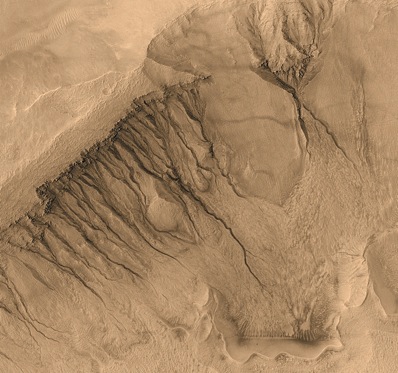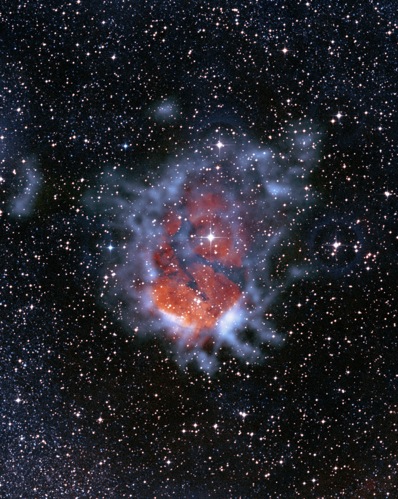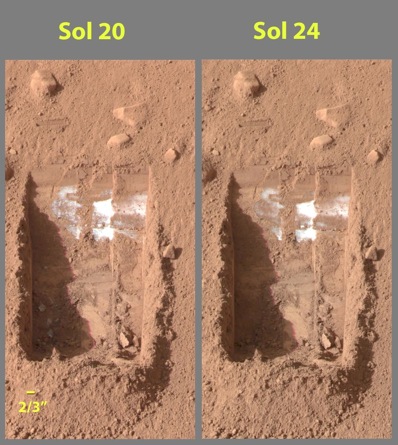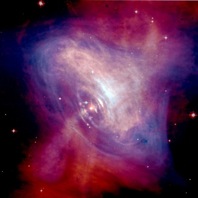Martian meteorites, surface process and the habitability of the red planet formed a key part of discussions at the UK Planetary Forum’s 6th Early Careers Planetary Scientists’ meeting held in London last week. Emily Baldwin reports on three up and coming PhD students and their extraterrestrial research.
The question of if and when water existed on Mars and its role in the history of the red planet is probably one of the most sought after answers in planetary science. Susan Conway of the Open University is studying the formation mechanisms of gullies on Mars by looking at similar examples here on the Earth. She suggests that since the current low average temperatures and pressures on Mars prevent the formation of liquid water, the discovery of recently active gullies on the surface of Mars presents a paradox.

Gullies like this on the Earth are usually formed by flowing water, but on Mars liquid water is unstable. Research into what has created the recent gullies on Mars is an active area of research for current early career scientists. Image: Malin Space Science Systems, MGS, JPL, NASA.
“The process forming gullies on Mars is unknown and it is through investigating the morphology of analogous sites on Earth that we hope to either rule out certain processes or find evidence for them occurring on Mars,” says Conway. Conway and colleagues undertook fieldwork in the Westfjords of Iceland where gullies share similarities with those on Mars, in terms of their shape and sinuosity (how much they bend and curve).
“In Iceland the gullies we have studied are formed by debris flow, a process by which a slurry of mud, rocks and water surges downslope. This process forms very distinctive landforms,” she says. By studying the Icelandic gullies, and comparing them with others from around the world, Conway found that the characteristics of Martian gullies shared many similarities with the terrestrial counterparts, meaning that debris flow as an active process on Mars – and possibly even including water – cannot be ruled out just yet. However, there is still a lot of work to be done, and Conway plans to study more gullies to increase the dataset.
“If we can show the morphology of the gullies on Mars is sufficiently similar to debris flow then we have a strong case for saying this process has been recently active on Mars,” she says. “This shows liquid water must have been present on the surface in the recent past, highlighting either that our current understanding of the behaviour of water under present Martian conditions is lacking or that our interpretation of the recent Martian climate is wrong.”
Earlier this year debris flows were reported on scarps on Mars that appeared as bright deposits in images taken by various orbiting Mars cameras separated by just a few years. After the initial excitement that this could have provided evidence for water on Mars, it turns out that dry debris flows, similar to an avalanche on Earth, are the most likely culprit. “The debris falls reported earlier this year do not form gullies,” comments Conway. “Due to the cold temperatures in this region, it is likely that these flows were entirely dry mass wasting.”

By studying environments on the Earth where volcanic activity and ice interact, such as in Iceland as shown here, scientists can learn about the potential habitability of similar environments on other planets such as Mars. Image: Clare Cousins.
Moving to astrobiology, but sticking with the watery theme, Claire Cousins of the Centre for Planetary Sciences at University College London presented her work on the potential for microbial colonisation on Mars, specifically where buried ice interacts with volcanic processes to give potentially life-giving heat to an otherwise harsh, frozen environment. “After an eruptive episode, subglacial volcanic systems produce a number of different environments that can be colonised by microbial life,” describes Cousins. “These include solidified lava, a lens of meltwater (which can be sustained by hydrothermal heating once the lava has cooled), and the overlying ice.”
The combination of geothermal energy and liquid water within a subsurface setting make subglacial volcanic systems an excellent refuge for life on Mars. “The presence of large amounts of water-ice plus widespread evidence for basaltic volcanism on Mars suggests the two must have interacted at some point in Martian history,” she says.
By performing experiments with microbes in simulated Martian icy conditions – which consisted of -30 degress Celsius temperatures, UV radiation and low pressure – and then subjecting the experiment to heat, Cousins and colleagues showed that the production of meltwater between the lava sample and the overlying ice offered a suitable environment for colonisation. “This strongly suggests this environmental setting could have been habitable on Mars at a time when volcanic activity and glaciers interacted,” she says.
However, problems may arise within the initial colonisation of a system because of the potential instability of these environments. “Once geothermal heat flow diminishes, or the overlying glacier retreats, the environments no longer exist,” says Cousins. That means that although you may have suitable environments, you need to somehow get the microbes there in the first place. Cousins comments that several volcanic systems can exist beneath the same glacier, therefore microbes could be transported via meltwater traveling through fractures and channels within the ice, thereby offering a solution to this problem.
“There is a lot of evidence that suggests subglacial volcanic activity occurred throughout Martian history, driving the need to understand these systems and resulting environments more fully,” adds Cousins. To date, only the top few centimetres of Martian soil have been probed; future missions such as ExoMars will include a drill to dig even deeper, and perhaps uncover potentially habitable environments buried at depth.

There is a lot of evidence for volcanic activity in Mars' past. Could volcanic activity combined with an icy environment at depth provide the magic ingredients for life? Claire Cousins of UCL has been finding out. Image: NASA.
While we have yet to return samples of Martian soil to the Earth, meteorites originating from the red planet are the next best thing, and give Julia Cartwright of the University of Manchester the tools to learn about the atmospheric and geological history of the planet. She studies a type of meteorite known as shergottites that account for over 80 percent of known Martian meteorites and which display evidence of undergoing a violent history. By looking at the composition, ratio and location of minerals contained within a meteorite, and the gases trapped within them, scientists can learn about the environment in which the meteorite originally formed, including details of the planet’s atmosphere and interior at the time of their genesis.
“The gases are incorporated into meteorites at some point in their histories, though the locations and trapping mechanisms of these gases has been heavily debated,” says Cartwright. The current theories propose that gases can form either within the mineral grains themselves, on the boundaries between grains or on the surfaces of the mineral, which relate to the mechanisms that put them there: either by being dissolved in the same magma that formed the grain, altered by water or formed in a high pressure event such as an impact, respectively.
Cartwright’s work on four different shergottites can answer questions regarding her meteorites’ ages and possible source locations. “The shergottites have very similar, young formation ages of 200-500 million years suggesting that they may have been formed in the same region and from the younger units on Mars, which only constitute a small proportion of the Martian surface. The shergottites also have very similar ejection ages of 1-4 million years, suggesting that they were ejected from Mars in just one of two ejection events.”

A photograph of a thin section of one of Cartwright’s Martian shergottite meteorites, with various minerals labelled. The left half of the image is shown in cross polarised light and the right side plane polarised light. By analysing the gases contained within meteorites, scientists can learn about the atmosphere and interior processes of Mars at the time the meteorite was formed and ejected from the planet. Image: Julia Cartwright.
But there is still work to be done to understand the processes that went into forming the different minerals contained within the meteorites, made all the more difficult by contamination by terrestrial processes resulting from the meteorites lying on the Earth’s surface for long periods of time. “Most meteorites will contain some sort of terrestrial component, though this will be determined by the amount of weathering that the meteorite has been subjected to,” she says. “Distinguishing between terrestrial and Martian weathering is very difficult, as similar minerals including clays, sulphates and carbonates are produced in both instances.”
Cartwright comments that a sample-return mission would be priceless regarding any further work on Mars. “Run in tandem to studies on meteorites, the information provided could be just the tip of the ice-berg when it comes to understanding not only the other planets in our Solar System, but our own planet Earth.”
Conway, Cousins and Cartwright were just three of twenty early career scientists presenting their work at the 6th UK Planetary Forum meeting, held at University College London on Monday 3 November. The UK Planetary Forum (UKPF) was founded in 1996 as a representative body of the planetary science community, and aims to promote planetary science in the UK amongst scientists and the public alike. For more information on the UKPF and for full listings of the talks presented, visit the UKPF website.
from:http://astronomynow.com/081108EarlycareerplanetaryscientistsexploreMars.html






 RSS Feed (xml)
RSS Feed (xml)




























